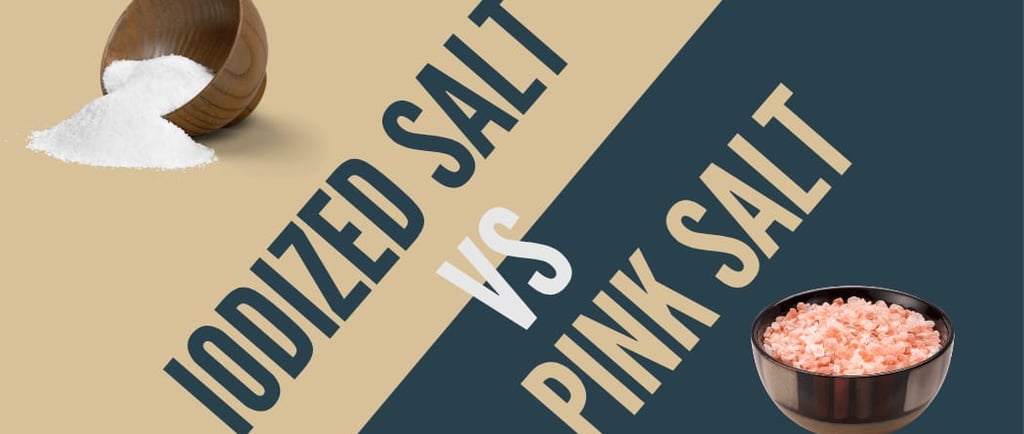Iodized salt vs Pink Salt
Which is better for your health?
3/29/20253 min read


Iodized Salt vs. Pink Salt: Which is Better for Your Health?
When it comes to choosing the right salt for your diet, two types often come up in conversation: iodized salt and pink salt. Both have their unique properties, benefits, and uses in the kitchen, but when it comes to health, which one should you choose? In this article, we will explore the differences between iodized salt and pink salt, so you can make an informed decision about what’s best for your health.
Iodized Salt: The Essential Mineral for Thyroid Health
Iodized salt is regular table salt that has been fortified with iodine, an essential trace mineral. Iodine plays a crucial role in the production of thyroid hormones, which regulate metabolism, growth, and energy levels. In fact, iodine deficiency is one of the leading causes of thyroid dysfunction, such as goiter and hypothyroidism, especially in regions where iodine-rich foods are scarce.
For this reason, iodized salt was introduced in the 1920s as a public health measure to prevent iodine deficiency. It’s an easy, inexpensive way to ensure that the population gets enough iodine, particularly in countries where the diet may not include sufficient iodine-rich foods like seafood, dairy products, or certain vegetables.
Iodized salt contains a small but effective amount of iodine, making it a convenient option for most people. As a result, it’s a go-to for individuals concerned about getting enough iodine in their diets. Additionally, iodized salt is widely available and relatively inexpensive, making it a practical option for many.
Pink Salt: A Trendy, Mineral-Rich Option
Pink salt, often referred to as Himalayan pink salt, is a type of rock salt primarily found in the Khewra Salt Mine in Pakistan. Unlike iodized salt, pink salt is less processed, and it retains more of its natural minerals, including potassium, magnesium, calcium, and iron, which give it its characteristic pink hue. These minerals are beneficial for maintaining hydration, supporting muscle function, and boosting overall health.
Pink salt is often marketed as a "healthier" alternative to table salt due to its mineral content, and while these minerals are indeed beneficial, they are present in such small amounts that they have a minimal impact on your overall health. Pink salt doesn’t contain any added iodine, which could be a concern for those who rely on their salt intake to meet their iodine needs.
While pink salt may look more appealing and have more minerals than regular salt, it’s important to remember that its sodium content is still similar to that of iodized salt. In fact, consuming too much pink salt can still lead to high sodium intake, which can contribute to high blood pressure and other health issues.
Which Salt Should You Choose?
The choice between iodized salt and pink salt depends on your specific health needs. If you live in an area where iodine deficiency is a concern or if you're not consuming enough iodine-rich foods, iodized salt is an essential part of your diet. It provides the iodine your thyroid needs to function properly, which is critical for overall health.
On the other hand, if you are looking for a salt that offers trace minerals, pink salt might appeal to you. However, you should be aware that its mineral content is not enough to significantly impact your health, and it’s important to ensure you’re still getting iodine from other sources, such as dairy, eggs, or seafood.
Ultimately, both iodized salt and pink salt can be part of a healthy diet when consumed in moderation. If iodine deficiency is a concern, iodized salt is the better option, while pink salt can be a more natural and aesthetically pleasing choice for culinary use. Regardless of which one you choose, it’s essential to use salt in moderation and pay attention to your overall sodium intake to support long-term health.
